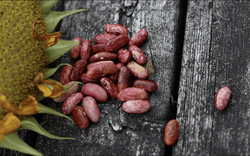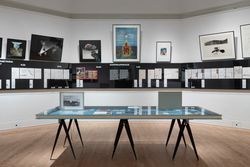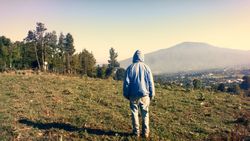articles
Liens ininterrompus
29 septembre 2025
Alors que le cinéma décentralisé, expérimental et subversif gagne en importance à la fin des années 1960 et au début des années 1970, de nombreux groupes opérant dans le domaine de l’architecture, tels que Superstudio, Studio 9999 et Ant Farm explorent le médium du court métrage comme moyen d’élargir le discours architectural, d’intégrer à leurs projets des réflexions(...)
salle octogonale
21 septembre 2018 au 19 mai 2019
Récits pour un monde nouveau
Actions:
Description:
Alors que le cinéma décentralisé, expérimental et subversif gagne en importance à la fin des années 1960 et au début des années 1970, de nombreux groupes opérant dans le domaine de l’architecture, tels que Superstudio, Studio 9999 et Ant Farm explorent le médium du court métrage comme moyen d’élargir le discours architectural, d’intégrer à leurs projets des réflexions(...)
salle octogonale
vidéo
Quantité:
11 film reel(s)
PHCON2003:0005:008
Description:
Contains film reels which include an original and outtakes. The contents of the individual film reels have now been put on two larger reels by an outside supplier before being returned by Jane Crawford to CCA. Only the original containers have been kept.
1976
Berlin: Super 8 original
Actions:
PHCON2003:0005:008
Description:
Contains film reels which include an original and outtakes. The contents of the individual film reels have now been put on two larger reels by an outside supplier before being returned by Jane Crawford to CCA. Only the original containers have been kept.
vidéo
Quantité:
11 film reel(s)
1976
Projet
AP148.S1.1970.PR02
Description:
The project series documents Poli's work on the Interplanetary Architecture project, which was also made into a film by Superstudio directed by Alessandro Poli (the film is not included in the fonds). The project reflects Poli's deep fascination with the moon landing in 1969. Poli uses this major media event as a catalyst for thinking about a new approach to architecture and tools for design, including the idea that film and the movie camera should become part of the toolset. The project also seems to be in some way a response to Epoch magazine's challenge for a "Primo concorso di architettura nello spazio" (the first architectural competition in space), and includes much imagery and textual references to a new road or architectural links between the earth and other planets, including an earth moon highway. In his storyboard, Poli also makes reference to his earlier Piper project, and some imagery features wheels and an amusement park. The Interplanetary Architecture project was exhibited by Superstudio in Rome in 1972 and featured in "Casabella" magazine in April 1972 (no. 364). The project was also featured in the 2010 CCA exhibition "Other Space Odysseys". In the accompanying CCA publication, Poli describes this project as "a voyage off earthbound routes in quest of architecture unfettered by the urban nightmare, by induced needs or by planning as the only tool for regulating and solving the world's problems" (Poli quoted in Borasi and Zardini, 2010, 110). Poli's work on this project is deeply tied to the Zeno project, which was also featured in this exhibition and is included in this fonds (see AP148.S1.1972.PR01). For the Zeno project, Poli envisioned a dialogue between astronaut Buzz Aldrin and an Italian peasant, Zeno of Riparbella. Poli felt that these two shared a similarity in that both their homes were isolated capsules, one that provided a lens from which to see the rest of the world and understand their place in it. The material in the series includes numerous photomontages and collages of astronauts in space, as well as drawings of plantery shapes and structures. There are also texts, some of which include calculations of distances and diameters of planets, as well as notebooks and sketchbooks, many of which Poli included in a folder he entitled "Storyboard." The series also includes an unsent letter from Poli to Adolfo Natalini which describes how, after the moon landing, everything - the planet, the moon, the stars - is architecture, and that this will necessitate the need for new design tools, such as the movie camera. Some works are signed Alessandro Poli-Superstudio. Source cited: Giovanna Borasi and Mirko Zardini, eds., Other Space Odysseys, Montreal and Baden: Canadian Centre for Architecture/Lars Müller Publishers, 2010.
1969-1971
Architettura Interplanetaria [Interplanetary Architecture] (1970-1971)
Actions:
AP148.S1.1970.PR02
Description:
The project series documents Poli's work on the Interplanetary Architecture project, which was also made into a film by Superstudio directed by Alessandro Poli (the film is not included in the fonds). The project reflects Poli's deep fascination with the moon landing in 1969. Poli uses this major media event as a catalyst for thinking about a new approach to architecture and tools for design, including the idea that film and the movie camera should become part of the toolset. The project also seems to be in some way a response to Epoch magazine's challenge for a "Primo concorso di architettura nello spazio" (the first architectural competition in space), and includes much imagery and textual references to a new road or architectural links between the earth and other planets, including an earth moon highway. In his storyboard, Poli also makes reference to his earlier Piper project, and some imagery features wheels and an amusement park. The Interplanetary Architecture project was exhibited by Superstudio in Rome in 1972 and featured in "Casabella" magazine in April 1972 (no. 364). The project was also featured in the 2010 CCA exhibition "Other Space Odysseys". In the accompanying CCA publication, Poli describes this project as "a voyage off earthbound routes in quest of architecture unfettered by the urban nightmare, by induced needs or by planning as the only tool for regulating and solving the world's problems" (Poli quoted in Borasi and Zardini, 2010, 110). Poli's work on this project is deeply tied to the Zeno project, which was also featured in this exhibition and is included in this fonds (see AP148.S1.1972.PR01). For the Zeno project, Poli envisioned a dialogue between astronaut Buzz Aldrin and an Italian peasant, Zeno of Riparbella. Poli felt that these two shared a similarity in that both their homes were isolated capsules, one that provided a lens from which to see the rest of the world and understand their place in it. The material in the series includes numerous photomontages and collages of astronauts in space, as well as drawings of plantery shapes and structures. There are also texts, some of which include calculations of distances and diameters of planets, as well as notebooks and sketchbooks, many of which Poli included in a folder he entitled "Storyboard." The series also includes an unsent letter from Poli to Adolfo Natalini which describes how, after the moon landing, everything - the planet, the moon, the stars - is architecture, and that this will necessitate the need for new design tools, such as the movie camera. Some works are signed Alessandro Poli-Superstudio. Source cited: Giovanna Borasi and Mirko Zardini, eds., Other Space Odysseys, Montreal and Baden: Canadian Centre for Architecture/Lars Müller Publishers, 2010.
Project
1969-1971
Interior view of the building systems control room on level 3, Shaughnessy House, Montréal, Québec
PH1989:0087
Description:
- Photographs PH1989:0087, PH1989:0095 and PH1989:0103 were taken through plastic film which was possibly used as a temporary curtain prior to the installation of the building systems control room door.
architecture
1989
Interior view of the building systems control room on level 3, Shaughnessy House, Montréal, Québec
Actions:
PH1989:0087
Description:
- Photographs PH1989:0087, PH1989:0095 and PH1989:0103 were taken through plastic film which was possibly used as a temporary curtain prior to the installation of the building systems control room door.
architecture
photographies
Interior view of the building systems control room on level 3, Shaughnessy House, Montréal, Québec
PH1989:0095
Description:
- Photographs PH1989:0087, PH1989:0095 and PH1989:0103 were taken through plastic film which was possibly used as a temporary curtain prior to the installation of the building systems control room door.
architecture
1989
Interior view of the building systems control room on level 3, Shaughnessy House, Montréal, Québec
Actions:
PH1989:0095
Description:
- Photographs PH1989:0087, PH1989:0095 and PH1989:0103 were taken through plastic film which was possibly used as a temporary curtain prior to the installation of the building systems control room door.
photographies
1989
architecture
photographies
Interior view of the building systems control room on level 3, Shaughnessy House, Montréal, Québec
PH1989:0103
Description:
- Photographs PH1989:0087, PH1989:0095 and PH1989:0103 were taken through plastic film which was possibly used as a temporary curtain prior to the installation of the building systems control room door.
architecture
1989
Interior view of the building systems control room on level 3, Shaughnessy House, Montréal, Québec
Actions:
PH1989:0103
Description:
- Photographs PH1989:0087, PH1989:0095 and PH1989:0103 were taken through plastic film which was possibly used as a temporary curtain prior to the installation of the building systems control room door.
photographies
1989
architecture
Documenter les déplacements propose dexplorer la notion de déplacement et ses diverses significations et effets dans des œuvres photographiques et vidéo dartistes qui sintéressent à cette notion à travers le sujet quils ont représenté ou à travers leurs méthodologies et processus eux-mêmes. Les artistes présentés dans cette série vivent et travaillent tous en Amérique du(...)
Théâtre Paul-Desmarais Mot(s)-clé(s):
Victor Arroyo, Documenter les déplacements, Hester Keijser, photography, Cherán, P’urhépecha
7 décembre 2023, 18h30
Documenter les déplacements III
Actions:
Description:
Documenter les déplacements propose dexplorer la notion de déplacement et ses diverses significations et effets dans des œuvres photographiques et vidéo dartistes qui sintéressent à cette notion à travers le sujet quils ont représenté ou à travers leurs méthodologies et processus eux-mêmes. Les artistes présentés dans cette série vivent et travaillent tous en Amérique du(...)
Théâtre Paul-Desmarais Mot(s)-clé(s):
Victor Arroyo, Documenter les déplacements, Hester Keijser, photography, Cherán, P’urhépecha
dessins, documents textuels, photographies
AP148.S1.1972.PR02.001
Description:
70 pages drawings and texts, with graphic materials interspersed throughout. Some textual documents are copies. Material in has been kept in the order in which Poli transferred it to the CCA, and was stored in 7 folders that reflect the divisions he created within the material. Includes materials for the film "Supersuperficie - Vita."
1972
Notes, sketches, and reprographic copies, Supersurface
Actions:
AP148.S1.1972.PR02.001
Description:
70 pages drawings and texts, with graphic materials interspersed throughout. Some textual documents are copies. Material in has been kept in the order in which Poli transferred it to the CCA, and was stored in 7 folders that reflect the divisions he created within the material. Includes materials for the film "Supersuperficie - Vita."
dessins, documents textuels, photographies
1972
L’enseignement de… Rome
Le cinéaste et photographe Armin Linke fait le point sur les changements sociétaux, la complexité culturelle et la beauté de la Rome contemporaine à travers deux courts métrages et des photographies d’architecture tirées de ses propres archives. Le premier film capture l’envol de 100 000 étourneaux qui se révèle une véritable chorégraphie avec Rome en toile de fond. Linke(...)
Théâtre Paul-Desmarais
5 mars 2009
L’enseignement de… Rome
Actions:
Description:
Le cinéaste et photographe Armin Linke fait le point sur les changements sociétaux, la complexité culturelle et la beauté de la Rome contemporaine à travers deux courts métrages et des photographies d’architecture tirées de ses propres archives. Le premier film capture l’envol de 100 000 étourneaux qui se révèle une véritable chorégraphie avec Rome en toile de fond. Linke(...)
Théâtre Paul-Desmarais




